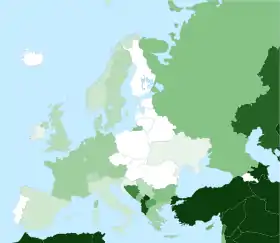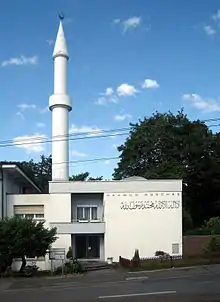Islam in Switzerland
Islam in Switzerland has mostly arrived via immigration since the late 20th century. Numbering below 1% of total population in 1980, the fraction of Muslims in the population of permanent residents in Switzerland has quintupled in thirty years, estimated at just above 5% as of 2013.[2] A majority is from Former Yugoslavia (estimated at 56% as of 2010, most of them from Kosovo); an additional 20% (2010 estimate) is from Turkey. This is due to the fact that in the 1960s and 1970s Switzerland encouraged young men from Yugoslavia and Turkey to come as guest workers.[3] Initially these young men were only planning on staying in Switzerland temporarily, however, revised Swiss immigration laws in the 1970s permitted family regrouping.[4] Consequently, these men ended up staying in Switzerland as these new laws allowed the wives and children of these young men into the country.[5] Since this time period, most of the Muslim immigration to Switzerland stems from asylum seekers arriving primarily from Eastern Europe.[6]

| 90–100% | |
| 70–80% | Kazakhstan |
| 50–70% | |
| 30–50% | North Macedonia |
| 10–20% | |
| 5–10% | |
| 4–5% | |
| 2–4% | |
| 1–2% | |
| < 1% |
| Islam by country |
|---|
 |
|
|

The vast majority of Muslims in Switzerland adhere to the Sunni branch.[7] Some famous Muslims of Switzerland include Tariq Ramadan, Frithjof Schuon, Titus Burckhardt, Xherdan Shaqiri and Isabelle Eberhardt.
Demographics
The largest concentration of Muslim population is in the German speaking Swiss plateau. The cantons with more than 5% Muslim population are:[8]
- 8.17% Basel-Stadt
- 7.72% Glarus
- 7.63% Solothurn
- 7.54% St. Gallen
- 7.14% Aargau
- 7.02% Schaffhausen
- 6.51% Thurgau
- 6.49% Zürich
- 6.24% Geneva
- 5.61% Basel-Landschaft
- 5.22% Vaud
Geneva is the only non-German-speaking canton where the Muslim population (6.24%) is slightly above the average (5.40%).[8] Another remarkable demographic feature in comparison to other European countries is the relatively equal distribution throughout the country[9] (compare Islam in the United Kingdom). No administrative unit has more than 8.55%[10] of Muslim population, and no town or village more than 16.8%.[11] The lowest percentage of Muslims in a canton is 1.82%[12] (the Italian-speaking Ticino).
88.3% of Muslims in Switzerland are foreigners (56.4% from former Yugoslavia, mostly Bosniaks, and Albanians from Kosovo), 20.2% from Turkey and 6% from Africa (3.4% from North Africa).[13] 10,000 of the 400,000 Muslims could be converts.[14]
History
In the 10th century, Arabs and Amazighs from their Mediterranean Fraxinet base settled in the Valais for a few decades. They occupied the Great St. Bernard Pass and even managed to reach as far as St. Gallen to the north and Raetia in the east.[15]
Islam was virtually absent from Switzerland until the 20th century. It appeared with the beginning of significant immigration to Europe, after World War II. A first mosque was built in Zürich in 1963 by the Ahmadiyya community. Muslim presence during the 1950s and 1960s was mostly due to the presence of international diplomats and rich Saudi tourists in Geneva.
Substantial Muslim immigration began in the 1970s, and accelerated dramatically over the 1980s to 1990s. In 1980, there were 56,600 Muslims in Switzerland (0.9% of total population). This ratio quintupled over the following thirty years, notably due to the immigration from Former Yugoslavia during the 1990s Yugoslav War. While the Muslim demographics is still growing rapidly, the rate of growth has decreased after the early 1990s. The growth rate corresponded to a factor of 2.7 over the 1980s (10% per annum), a factor of 2.0 over the 1990s (7% p.a.), and a factor of about 1.6 over the 2000s (5% p.a.).[16]
The burka was outlawed in the canton of Ticino after a citizen initiative to hold a referendum. With 65% in favour of a ban and it was ruled that the ban was constitutional, the ban took effect in July 2016. Those who violate the law face a fine of up to CHF 10,000.[17] One of the primary figures behind this burka ban is now attempting to ban Muslims from praying in public.[18]
In 2017, an Imam was charged for inciting violence by calling a sermon for Muslims who refused to pray to be burned alive.[19]
In 2018, a Muslim couple was denied citizenship when they refused to answer questions from members of the Lausanne naturalisation board if they were asked by people of the opposite sex. Their behaviour was found to disrespect a fundamental principle of the Swiss constitution, equality between men and women.[20]
In September 2018, a ban on face-covering veils was approved with a 67% vote in favour in the canton of St Gallen. The largest Islamic community organisation in Switzerland, the Islamic Central Council, recommended that Muslim women continue to cover their faces.[21]
Organizations
Swiss Muslim organizations begin to form in the 1980s. An umbrella organization (GIOS, Gemeinschaft islamischer Organisationen der Schweiz) was formed in Zürich in 1989. Numerous organizations were formed during the 1990s to 2000s, including
- 1994 Organisation Muslime und Musliminnen der Schweiz
- 1995 Vereinigung Islamischer Organisationen Zürich (VIOZ), Zurich
- 1997 Basler Muslim Kommission, Basle
- 2000 Koordination Islamischer Organisationen Schweiz (KIOS), Berne
- 2002 Vereinigung islamischer Organisationen des Kantons Luzern (VIOKL), Lucerne
- 2003 Dachverband islamischer Gemeinden der Ostschweiz und des Fürstentums Liechtenstein
- 2006 Föderation Islamischer Dachorganisationen in der Schweiz (FIDS)
- 2009 Islamic Central Council of Switzerland (ICCS; German Islamischer Zentralrat Schweiz IZRS), Berne. IZRS is a comparatively minor organisation (with an estimated 960 members in 2010) but has a disproportionate media presence because of its radical Salafist orientation and because a disproportionate number of its members (an estimated 10%) are native Swiss converts.[22]
Mosques

It is estimated that there are 260 mosques and prayer rooms with connected services in Switzerland.[23] Switzerland has the second lowest mosques per Muslim inhabitant, with about one mosque to every 4000 Muslims in Switzerland.[24]
There are two Swiss mosques which predate 1980 and the rapid increase of immigration of Muslims from the Balkans and Turkey over the following decades. Today, there are numerous mosques and prayer rooms across the country, predominantly in the urban parts of the Swiss plateau.[25]
In 2007 the Bern city council rejected plans to build one of the largest Islamic cultural centers in Europe.[26]
Four Swiss mosques have minarets, there is a mosque in Zurich, a mosque in Geneva, a mosque in Winterthur, a mosque in Wangen bei Olten. The latter was erected in 2009 following several years of political and legal disputes. In the wake of the Wangen minaret controversy, a popular initiative was passed with 57.5% of the popular vote in November 2009, introducing a ban on the construction of new minarets. The four existing minarets are not affected by the ban.[27][28] Although the Swiss People's Party won the poll, the campaign was rocked by the conversion to Islam of Daniel Streich, a council member from the party. Streich left the SPP in opposition to their campaign against new minarets. The referendum also prompted concerns from other countries, with the perception that the Swiss electorate was increasingly shifting towards the right.
Attitudes
In a 2018 survey conducted by Switzerland's Federal Statistics Office, 29% of Swiss respondents said they mistrusted Islam and 11% said they mistrusted Islamic followers.[29] Comparatively, in 2016, 14% of Swiss respondents said that they mistrusted Islamic followers.[30]
References
- "Religious Composition by Country, 2010-2050". Pew Research Center. 12 April 2015. Retrieved 22 October 2017.
- The Federal Statistical Office reported the religious demographics as of 2013 as follows (based on the resident population older than 15 years): total population of Muslims aged 15 or older: 341,572 (confidence interval ±1.8%, i.e. ±6150, based on a total (100%) of 6,744,794 registered resident population above 15 years). This corresponds to 5.1%±0.1% of total (adult) population. "Ständige Wohnbevölkerung ab 15 Jahren nach Kanton und Religions- und Konfessionszugehörigkeit 2013" (XLS). bfs.admin.ch (Statistics) (in German). Neuchâtel: Swiss Federal Statistical Office. 2015. Retrieved 10 July 2015.
- Abbas, Tahir; Hamid, Sadek (2019-02-11). Political Muslims: Understanding Youth Resistance in a Global Context. Syracuse University Press. ISBN 9780815654308.
- Dodd, Savannah D. (2015-01-02). "The Structure of Islam in Switzerland and the Effects of the Swiss Minaret Ban". Journal of Muslim Minority Affairs. 35 (1): 43–64. doi:10.1080/13602004.2015.1007665. ISSN 1360-2004. S2CID 144170410.
- Dodd, Savannah D. (2015-01-02). "The Structure of Islam in Switzerland and the Effects of the Swiss Minaret Ban". Journal of Muslim Minority Affairs. 35 (1): 43–64. doi:10.1080/13602004.2015.1007665. ISSN 1360-2004. S2CID 144170410.
- Lathion, Stephane (2008-04-01). "Muslims in Switzerland: Is Citizenship Really Incompatible with Muslim Identity?". Journal of Muslim Minority Affairs. 28 (1): 53–60. doi:10.1080/13602000802011077. ISSN 1360-2004. S2CID 144696568.
- http://www.pewforum.org/files/2009/10/Muslimpopulation.pdf
- Statistik, Bundesamt für (2019-01-29). "Ständige Wohnbevölkerung ab 15 Jahren nach Religionszugehörigkeit und Kanton - 2017 | Tabelle". Bundesamt für Statistik (in German). Retrieved 2019-01-29.
- Islam in Switzerland
- Statistik, Bundesamt für (2019-01-29). "Ständige Wohnbevölkerung ab 15 Jahren nach Religionszugehörigkeit und Kanton - 2017 | Tabelle". Bundesamt für Statistik (in German). Retrieved 2019-11-10.
- Statistik, Bundesamt für (2019-01-29). "Ständige Wohnbevölkerung ab 15 Jahren nach Religionszugehörigkeit und Kanton - 2017 | Tabelle". Bundesamt für Statistik (in German). Retrieved 2019-11-10.
- Statistik, Bundesamt für (2019-01-29). "Ständige Wohnbevölkerung ab 15 Jahren nach Religionszugehörigkeit und Kanton - 2017 | Tabelle". Bundesamt für Statistik (in German). Retrieved 2019-11-10.
- Bovay, Claude; Raphaël Broquet (December 2004), Recensement fédéral de la population 2000 (PDF) (in French), Neuchâtel: Federal Statistical Office, pp. 49–50, ISBN 3-303-16074-0, retrieved 21 August 2010
- Marbach, Patrick (21 June 2010). "Les Suisses se tournent vers l'islam par amour". 20 minutes (in French). 20 minutes Romandie SA. p. 6.
- Wenner, M. (1980). "The Arab/Muslim Presence in Medieval Central Europe." International Journal of Middle East Studies, Vol.12 No.(1), 59-79. doi:10.1017/S0020743800027136
- Wohnbevölkerung nach Religion (bfs.admin.ch)
- "Muslims face fines up to £8,000 for wearing burkas in Switzerland". The Independent. 8 July 2016. Retrieved 8 July 2016.
- "Swiss burqa ban campaigner calls for ban on Muslim prayers in public". www.thelocal.ch. 2019-02-13. Retrieved 2019-11-08.
- Eddy, Melissa (2017-08-11). "Imam in Switzerland Urged Burning of Muslims Who Don't Pray, Prosecutors Say". The New York Times. ISSN 0362-4331. Retrieved 2019-11-10.
- "Couple denied Swiss citizenship over handshake refusal". SWI swissinfo.ch. Retrieved 2018-08-19.
- Editorial, Reuters. "Swiss canton becomes second to ban burqas in public". U.S. Retrieved 2018-09-24.
- Katia Murmann, Schweiz am Sonntag, 17 April 2010.
- Abbas, Tahir; Hamid, Sadek (2019-02-11). Political Muslims: Understanding Youth Resistance in a Global Context. Syracuse University Press. ISBN 9780815654308.
- Dodd, Savannah D. (2015-01-02). "The Structure of Islam in Switzerland and the Effects of the Swiss Minaret Ban". Journal of Muslim Minority Affairs. 35 (1): 43–64. doi:10.1080/13602004.2015.1007665. ISSN 1360-2004. S2CID 144170410.
- International Religious Freedom Report 2006 Switzerland
- Bern city says no to Islamic cultural centre, Swissinfo, June 1, 2007
- Rightwingers want nationwide vote on minarets, Swissinfo, May 3, 2007
- Swiss Referendum Stirs a Debate About Islam. Wall Street Journal Europe, 06 November 2009
- "Mistrust of Islam nearly three times higher than negative views of muslims". Le News. 2019-02-27. Retrieved 2019-11-08.
- "Mistrust of Islam nearly three times higher than negative views of muslims". Le News. 2019-02-27. Retrieved 2019-11-08.
Further reading
- Marcel Stüssi MODELS OF RELIGIOUS FREEDOM: Switzerland, the United States, and Syria by Analytical, Methodological, and Eclectic Representation, 375 ff. (Lit 2012)., by Marcel Stüssi, research fellow at the University of Lucerne.
External links
- Swiss Exile: European Muslim Congress, 1935 by Martin Kramer.
- Islam in Switzerland
- Centre Al Hikma de Lausanne - Réseau social
.svg.png.webp)